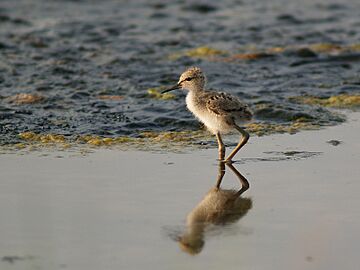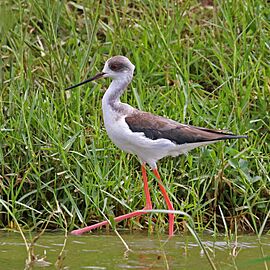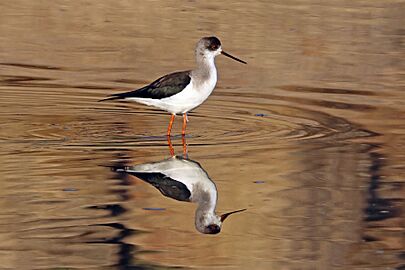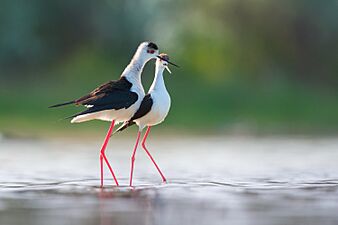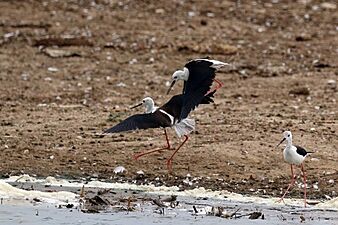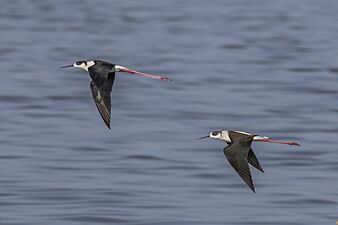Black-winged stilt facts for kids
Quick facts for kids Black-winged stilt |
|
|---|---|
 |
|
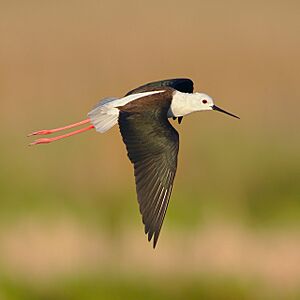 |
|
| H. h. meridionalis (South Africa) | |
| Conservation status | |
| Scientific classification | |
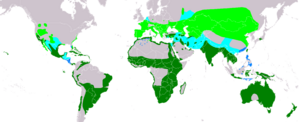 |
|
| Range of H. himantopus (sensu lato, see text)
Breeding Resident Passage Non-breeding |
|
| Synonyms | |
|
The black-winged stilt (Himantopus himantopus) is a tall, slender bird with very long legs. It's part of the avocet and stilt family, called Recurvirostridae. You can find these birds in many parts of the world.
Its scientific name, Himantopus himantopus, is sometimes used for one big group of stilts found all over the world. Other times, it refers only to the stilts common in Europe, Asia, and Africa. There are other types of stilts too. For example, the black-necked stilt lives in the Americas. The pied stilt is found in places like Australasia and New Zealand. Experts today usually agree there are between one and four different species of stilts.
Understanding the Black-winged Stilt's Name
The black-winged stilt was first officially described in 1758. This was done by a Swedish scientist named Carl Linnaeus. He wrote about it in his famous book, Systema Naturae. At first, he put it in the same group as plovers.
The name Himantopus comes from an old Greek word. It means "strap-foot" or "thong-foot," which describes their long, thin legs. The black-winged stilt is now one of five species in the Himantopus group. This group was named by a French scientist in 1760. This particular species is considered "monotypic," meaning it doesn't have different subspecies.
Sometimes, all the different kinds of stilts are grouped together as one big species. This larger group is often called the common stilt. However, the name "black-winged stilt" usually refers to the specific type found from Europe to South Asia and in Africa.
What Does a Black-winged Stilt Look Like?
Adult black-winged stilts are about 33 to 36 centimeters (13 to 14 inches) long. They have very long, bright pink legs. Their bill is long, thin, and black.
Most of their body is black on top and white underneath. Their head and neck are white, but they can have different amounts of black markings. This depends on the specific type of stilt.
- Males usually have a black back. This black often has a shiny green look.
- Females have a brownish back. This color stands out against their black wing feathers.
- In places where their heads are usually white, females tend to have less black on their heads and necks all year. Males often have more black, especially in summer. However, this isn't always a clear difference. Males can also have all-white head feathers in winter.
Younger stilts look a bit different. They are grey instead of black. Their wings have a sandy color. You can see a light, whitish line on their wings when they fly.
-
immature
Kazinga Channel, Uganda
Where Do Black-winged Stilts Live and What Do They Eat?
Black-winged stilts like to live and breed in marshes, shallow lakes, and ponds. Some groups of these birds migrate, meaning they fly to ocean coasts for the winter. Birds in warmer areas usually stay in one place or travel short distances.
In Europe, black-winged stilts sometimes fly further north than their usual homes in spring. They might even stay and breed in northern European countries. For example, they successfully bred in Britain in 1987. After a long break, they bred again in southern England in 2014 and 2017. In 2022, four chicks successfully grew up in northern England. This was the furthest north they had ever bred!
These birds find their food by picking it up from sand or water. They mostly eat insects and small crustaceans, like tiny crabs.
When it's time to nest, they choose a bare spot on the ground close to water. Black-winged stilts often nest in small groups. Sometimes, they even nest alongside avocets.
The black-winged stilt is an important bird. It is covered by an agreement called the Agreement on the Conservation of African-Eurasian Migratory Waterbirds. This agreement helps protect birds that migrate across Africa and Eurasia.




